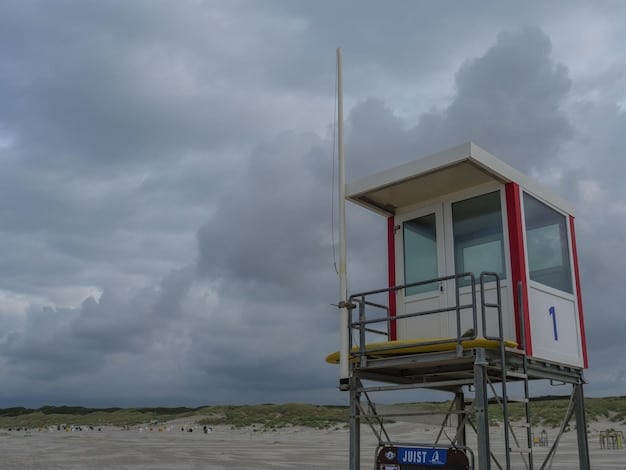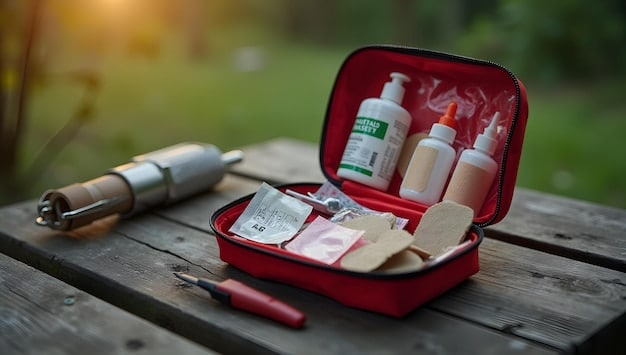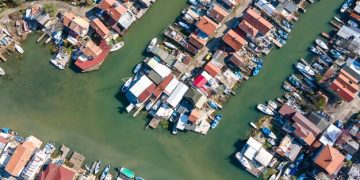Hurricane Season 2025: Coastal Preparedness Guide

Coastal residents must proactively update their hurricane preparedness plans for the 2025 season by securing property, assembling emergency kits, understanding evacuation routes, and staying informed through official channels to mitigate risks effectively.
As the warmth of summer settles in, a different kind of anticipation also begins to build for those living along the coasts: Hurricane Season 2025: Updated Preparedness Guide for Coastal Residents. This annual period brings with it the potential for significant weather events, demanding a proactive and informed approach from every individual residing in vulnerable areas. Preparing thoroughly is not merely a recommendation; it is an essential aspect of safeguarding lives, homes, and communities.
Understanding the 2025 Hurricane Season Outlook
The 2025 hurricane season brings with it new challenges and updated projections, making it critical for coastal residents to understand the broad strokes of what to expect. While precise forecasts for individual storms are impossible this far out, meteorological patterns and historical data allow experts to provided educated predictions regarding the overall activity level. These outlooks are not just numbers; they inform the urgency and scope of preparedness efforts for millions.
Understanding these macro trends helps residents gauge the general threats they might face. For instance, factors like ocean water temperatures in the Atlantic, the presence or absence of El Niño or La Niña conditions, and atmospheric wind patterns all play significant roles in determining storm formation and intensity. Scientific agencies and private forecasting services dedicate immense resources to providing these seasonal outlooks. Though subject to change, these early assessments provide a crucial starting point for tailored preparedness.
Key Factors Influencing 2025 Projections
Several elements combine to create the complex tapestry of a hurricane season. For 2025, forecasters will be keenly observing:
- Sea Surface Temperatures: Warmer Atlantic waters provide more energy for tropical cyclones to form and intensify. Predictions often consider anomalies in these temperatures.
- El Niño/La Niña Conditions: These climate patterns significantly impact wind shear in the Atlantic. La Niña typically reduces wind shear, leading to more active hurricane seasons, while El Niño tends to increase it, suppressing activity.
- African Easterly Waves: Many powerful Atlantic hurricanes originate from disturbances that move off the African coast. The strength and frequency of these waves are crucial indicators.
Monitoring these factors allows for a more nuanced understanding of the potential risks. Residents should keep an eye on official updates throughout the spring and early summer leading up to the season’s official start, as these projections become more refined.
Official Forecast Sources and Their Importance
Relying on credible, scientific sources for hurricane season predictions is paramount. Agencies such as the National Oceanic and Atmospheric Administration (NOAA) and national weather services are the go-to authorities. Their forecasts are:
- Scientifically Rigorous: Based on extensive data, climate models, and expert analysis.
- Publicly Accessible: Available through their websites, press releases, and via news outlets.
- Continuously Updated: Seasonal outlooks are refined as the season approaches and progresses.
These official forecasts, while not predicting landfall, offer valuable insights into the expected number of named storms, hurricanes, and major hurricanes. This information allows for a scaled approach to preparedness, helping coastal communities and individual residents allocate resources and attention appropriately.
In essence, staying informed about the 2025 hurricane season outlook is the first step in a robust preparedness strategy. It sets the stage for understanding the potential scale of the challenge and underscores the importance of proactive measures far in advance of any specific storm.
Establishing Your Emergency Action Plan
A well-defined emergency action plan is the cornerstone of hurricane preparedness. It’s not enough to simply have supplies; knowing what to do, where to go, and how to communicate are equally vital. This section outlines the essential components of a robust plan, ensuring every family member understands their role when a storm threatens.
The plan should be dynamic, regularly reviewed, and practiced by all members of the household. It should cover scenarios ranging from a direct hit necessitating evacuation to a prolonged power outage requiring sheltering in place. The goal is to minimize confusion and maximize efficiency during the stress of an emergency.
Pre-Designating Evacuation Routes and Shelters
Knowing your evacuation options before a storm hits is non-negotiable. Official evacuation zones are typically designated by local authorities, and residents should familiarize themselves with their specific zone. It’s wise to plan not just one, but multiple routes, as main thoroughfares can become congested or impassable.
- Identify Official Evacuation Routes: Check local emergency management websites or apps for designated routes from your area.
- Locate Safe Shelters: Research official public shelters in your region, but also consider arrangements with friends or family outside the evacuation zone.
- Consider Pet Accommodations: Many public shelters do not accept pets, so plan for their safety as well.
A dry run of your evacuation route, even if just virtually, can reveal potential bottlenecks or issues. Having a pre-determined destination reduces decision fatigue during a critical time.
Communication Strategy for Family Members
During and after a hurricane, traditional communication methods like cell service can become unreliable. A clear communication plan ensures everyone can reconnect and account for one another.
- Out-of-State Contact: Designate a single out-of-state contact person whom all family members can check in with. This centralizes communication if local lines are down.
- Pre-Programmed Numbers: Ensure all family members, especially children with phones, have important numbers (emergency contact, out-of-state contact, local emergency services) pre-programmed or written down.
- Low-Tech Alternatives: Consider having a battery-powered or hand-crank radio for receiving updates, and a whistle to signal for help.
Practicing this communication strategy, even through simple check-ins, can reinforce its importance and make it second nature when needed. The goal is to avoid frantic searches and ensure everyone’s safety is confirmed.
An emergency action plan is a living document. It should be updated annually to reflect any changes in family circumstances, local infrastructure, or official guidelines. By taking the time to prepare comprehensively, coastal residents can face the 2025 hurricane season with greater confidence and resilience.
Building Your Comprehensive Emergency Kit
While an action plan guides your movements, a well-stocked emergency kit sustains you when services are disrupted. This kit is more than just a box of supplies; it’s a lifeline designed to support your household for at least 72 hours, if not longer, especially if access to basic necessities becomes difficult. The emphasis for 2025 shifts towards self-sufficiency and adaptability.
Building this kit should be a year-round process, not a last-minute scramble. It requires thoughtful consideration of your family’s unique needs, including medications, dietary restrictions, and specific items for infants, elderly, or those with disabilities. A truly comprehensive kit is personalized and regularly maintained.
Essential Supplies for 72+ Hours
The core of any emergency kit revolves around sustenance and basic needs. Think beyond the immediate aftermath and consider the possibility of prolonged isolation.
- Water: At least one gallon per person per day for drinking and sanitation. Have a minimum of a three-day supply, but ideally more.
- Food: Non-perishable, easy-to-prepare items for several days. Include manual can opener if necessary.
- Light and Power: Battery-powered or hand-crank flashlight, extra batteries, and a portable power bank for charging devices.
- First Aid Kit: Comprehensive kit with sterile gloves, bandages, antiseptic wipes, pain relievers, and any necessary prescription medications (with a 7-day minimum supply).
- Sanitation and Hygiene: Wet wipes, hand sanitizer, garbage bags, personal hygiene items.
Beyond these, consider a whistle to signal for help, duct tape, a multi-tool, and local maps if GPS becomes unavailable.

Documents and Valuables Safeguarding
Losing critical documents can complicate recovery efforts immensely. Protecting invaluable papers and personal items is a crucial, often overlooked, aspect of preparedness.
- Important Documents: Copies of insurance policies, identification, medical records, bank account information, and birth certificates stored in a waterproof, fireproof container or digitally on an encrypted drive.
- Cash: Small bills for purchases, as ATMs and credit card machines may be non-functional after a widespread power outage.
- Valuables: Consider a small, portable container for sentimental items or jewelry that you can quickly grab if evacuation is necessary.
Photocopying these documents or scanning them into a cloud storage service provides redundancy. Keep a hard copy version readily accessible in your emergency kit.
Regularly check expiration dates on food and water, replace batteries, and update medications annually. A well-maintained kit provides peace of mind and practical support when it’s most needed, serving as a critical layer of defense during the 2025 hurricane season.
Property Protection and Home Hardening Measures
Protecting your property before a hurricane strikes can significantly reduce structural damage and accelerate recovery. “Home hardening” refers to a series of strategic improvements and immediate actions designed to make your residence more resilient to high winds, heavy rain, and storm surge. This proactive approach saves not only money but also stress in the long run.
From reinforcing entry points to managing surrounding landscaping, every measure contributes to the overall integrity of your home. It’s about creating a robust barrier against the elements, minimizing vulnerabilities that could allow a storm to wreak havoc.
Securing Windows, Doors, and Garage Doors
These are often the weakest points in a home’s exterior envelope, making them prime targets for wind damage and water intrusion. Reinforcing them is a top priority.
- Hurricane Shutters: Permanently installed shutters (accordion, roll-down, panel) offer the best protection. Plywood cut to size and pre-drilled for quick installation is a cost-effective alternative.
- Door Reinforcement: Ensure all exterior doors, especially double-entry doors, have strong deadbolts and multiple sturdy locks. Consider reinforcing garage doors with vertical braces or horizontal stiffeners, as they are often large and vulnerable.
- Impact-Resistant Glass: If you are remodeling or building, consider impact-resistant windows and doors, which can withstand high-speed debris.
Even small cracks or openings can allow wind to enter, creating pressure that can lift roofs or blow out walls. Sealing these entry points is key.
Landscaping and Outdoor Object Management
Anything unsecured outdoors can become a dangerous projectile in high winds. Managing your yard and surrounding environment is a critical pre-storm task.
- Trim Trees and Shrubs: Prune dead or weak branches that could break off and cause damage to your home or power lines. Consider hiring a professional arborist for large, mature trees.
- Secure Outdoor Furniture: Bring inside or securely tie down all patio furniture, grills, trash cans, and garden ornaments. If possible, store them in a garage or shed.
- Clear Gutters and Drains: Ensure gutters are clear of debris to allow rainwater to flow freely away from your home, preventing water intrusion and foundation damage.
These seemingly minor steps can prevent significant damage and injury. A thorough sweep of the property before a storm’s arrival is a simple yet effective protective measure.

Investing time and resources in property protection yields substantial returns in terms of safety and reduced repair costs. It represents a tangible commitment to resilience, preparing your home to withstand the potential impacts of the 2025 hurricane season.
Navigating the Storm: During and After Strategies
The moment a hurricane warning is issued, your preparedness shifts from planning to execution. How you act during the storm and what you do immediately afterward are crucial for safety and recovery. This section outlines practical strategies for navigating the most challenging phases of a hurricane event.
These strategies emphasize safety, communication, and resourcefulness. Being prepared to endure potential isolation and disruption of services is key to minimizing post-storm distress and facilitating a quicker return to normalcy.
Actions to Take During the Storm
Once a hurricane begins to impact your area, move to internal, safe areas of your home. Stay calm and focus on safety.
- Stay Indoors and Away from Windows: Seek shelter in an interior room, closet, or hallway on the lowest floor. Avoid windows and glass doors, which can shatter from wind pressure or flying debris.
- Monitor Official Updates: Use a battery-powered, hand-crank, or car radio to listen for official storm updates, evacuation orders, or “all clear” signals. Do not rely on cell phones or internet if power is out.
- Avoid Using Landlines (Unless Emergency): In older homes, landlines can conduct electricity if power lines are down, posing a shock risk.
- Do Not Go Outside During the Eye: If the eye of the storm passes over, there may be a temporary calm. Do not be fooled; the winds will return with similar intensity from the opposite direction.
Prioritize personal safety over property concerns during the height of the storm. Property can be replaced; lives cannot.
Post-Storm Recovery and Safety Precautions
The period immediately after a hurricane can be as dangerous as the storm itself. Hidden hazards and damaged infrastructure pose significant risks.
- Wait for Official “All Clear”: Do not leave your shelter until local authorities issue an “all clear” announcement. Roads may be flooded, blocked by debris, or have downed power lines.
- Be Wary of Hazards:
- Downed Power Lines: Assume all downed power lines are live and extremely dangerous. Report them to utility companies immediately.
- Floodwaters: Avoid walking or driving through floodwaters. They can hide debris, open manholes, or be electrically charged. “Turn around, don’t drown.”
- Damaged Buildings: Stay out of damaged buildings as they may be structurally unsound.
- Check for Injuries and Provide First Aid: Tend to any injuries within your household. If serious, call for emergency services if safe to do so.
- Contact Your Out-of-State Person: As soon as communication is possible, check in with your designated out-of-state contact to let them know you are safe.
- Document Damage: Before cleaning up, take photos and videos of all damage to your property for insurance claims.
Patience and caution are paramount in the aftermath of a hurricane. Recovery is a marathon, not a sprint, and adhering to safety guidelines will protect you and your loved ones during this challenging period. The 2025 hurricane season demands this level of vigilance.
Community Resources and Support Networks
No individual or family is an island in the face of a major storm. Community resources and established support networks play a vital role in both preparedness and recovery. Understanding these lifelines, and knowing how to access them, is an integral part of a comprehensive hurricane strategy. It fosters resilience at a broader level, reinforcing the idea that collective action strengthens individual safety.
From local emergency management agencies to volunteer organizations, these networks provide information, aid, and a sense of collective purpose. Engaging with them proactively builds a stronger, more prepared coastal community, ready to face the challenges of the 2025 hurricane season together.
Local Emergency Management Agencies
These agencies are the cornerstone of local hurricane preparedness and response. They disseminate critical information and coordinate efforts.
- Official Information Hub: Your local emergency management office provides zone-specific evacuation routes, lists of public shelters, and real-time updates during a storm.
- Alert Systems: Sign up for local emergency alerts (e.g., reverse 911 calls, text messages, email notifications) that provide timely warnings and instructions.
- Preparedness Guides: Many agencies offer free preparedness guides, checklists, and workshops for residents.
Familiarizing yourself with your county or city’s emergency management website and social media channels before the season starts is a crucial first step. These are the authoritative voices when a storm approaches.
Volunteer Organizations and Aid Groups
Beyond official government bodies, numerous volunteer and non-profit organizations offer invaluable support during and after hurricanes. They often provide immediate relief, long-term assistance, and essential services.
- American Red Cross: Offers shelter, food, and emotional support to disaster victims. They also provide training in first aid and disaster preparedness.
- Salvation Army: Provides food, hydration, and comfort to first responders and survivors during and after disasters.
- Local Community Groups: Many towns have neighborhood watch groups, churches, or civic organizations that coordinate local relief efforts, check on vulnerable residents, and organize clean-up drives.
Knowing which organizations operate in your area and what services they typically provide can guide you on where to seek help, or even where to offer help, if you are able. These networks create a robust safety net for communities.
Participation in community discussions or preparedness events can also foster neighborly bonds, creating informal support systems that can be just as vital as formal ones. Sharing resources, checking on elderly neighbors, and coordinating clean-up efforts are powerful demonstrations of community resilience. By leveraging both official and informal networks, coastal residents can significantly enhance their ability to withstand and recover from the impacts of the 2025 hurricane season.
Long-Term Resilience and Financial Preparedness
Surviving a hurricane is one challenge; recovering and rebuilding is another. Long-term resilience extends beyond immediate safety measures, encompassing financial planning, insurance reviews, and a commitment to sustainable living practices. It’s about minimizing the lasting impact on your life and ensuring a smoother path to recovery in the wake of significant events.
This includes understanding your financial safety nets, adapting your property for future events, and considering the broader environmental picture. A truly prepared resident looks beyond the next storm and plans for the future of their coastal home and community.
Reviewing Insurance Policies
Insurance is a critical component of financial recovery. Many homeowners mistakenly believe their standard policy covers all hurricane-related damage. This is rarely the case.
- Flood Insurance: Standard homeowner policies typically do NOT cover flood damage. This requires a separate policy, often through the National Flood Insurance Program (NFIP). There’s usually a 30-day waiting period for flood insurance to take effect, so don’t wait until a storm is brewing.
- Windstorm Insurance: In some hurricane-prone areas, wind damage may be excluded from standard policies or require a separate deductible. Review your policy carefully or consult with your agent.
- Documentation: Maintain a detailed inventory of your home’s contents and their value, preferably with photos or videos. This greatly assists with claims processing.
Understanding your coverage, deductibles, and claim procedures before a storm can prevent significant financial hardship down the line.
Financial Preparedness and Savings
Beyond insurance, having readily accessible funds can bridge gaps in recovery and cover immediate needs not covered by policies.
- Emergency Fund: Aim to have at least 3-6 months of living expenses saved in an easily accessible account. This can cover unexpected costs, temporary housing, or lost wages.
- Access to Funds: Keep a small amount of cash on hand in various denominations, as credit card systems and ATMs may be down after a major outage.
- Credit Card for Emergencies: Have a low-interest credit card available for emergency expenses, but use it judiciously.
These financial cushions provide flexibility and reduce stress during an already difficult time. They empower you to make necessary purchases without immediate concern for liquidity.
Long-term resilience also involves engaging with local government and community groups on infrastructure improvements, advocating for resilient building codes, and understanding how climate change may impact future hurricane seasons. By taking a holistic approach—from individual financial planning to community-wide initiatives—coastal residents can build a more secure future, even in the face of increasingly unpredictable weather patterns. The lessons learned from previous seasons inform stronger, more robust strategies for Hurricane Season 2025: Updated Preparedness Guide for Coastal Residents and beyond.
| Key Point | Brief Description |
|---|---|
| ✅ Emergency Kit | Assemble a 72-hour kit with water, food, first aid, and essential documents. |
| 🏡 Property Prep | Secure windows/doors, trim trees, and clear outdoor items to minimize damage. |
| 🗺️ Evacuation Plan | Pre-plan routes, designated shelters, and out-of-state family contacts. |
| 💰 Financial Ready | Review insurance policies (flood/wind), build savings, and keep cash accessible. |
Frequently Asked Questions About Hurricane Preparedness in 2025
The most critical item is water, with at least one gallon per person per day for drinking and sanitation, ideally for a minimum of three to seven days. Beyond sustenance, a reliable form of communication, like a battery-powered radio for official updates, is also paramount to staying safe and informed during an outage.
You should review and update your hurricane preparedness plan annually, ideally before the start of each hurricane season. This ensures all contact information is current, emergency supplies are not expired, and your evacuation routes and designated meeting places still make sense for your family’s evolving needs and local conditions. Regular reviews are key.
Standard homeowner’s insurance policies typically do not cover flood damage; a separate flood insurance policy, often through the NFIP, is required. Wind damage may also have a separate deductible or exclusion in certain high-risk areas. It is crucial to review your specific policy with your agent to understand your coverage for the 2025 season.
The best way to stay informed is through official sources. Rely on alerts from your local emergency management agency, NOAA Weather Radio, and reputable news outlets. Download official weather apps that provide real-time updates directly from the National Weather Service. Avoid relying solely on social media for critical, time-sensitive information during a storm.
A voluntary evacuation order indicates that conditions are becoming dangerous, especially for vulnerable populations or those in low-lying areas. While not mandatory, it is strongly advised to evacuate during a voluntary order. This allows you to leave safely before conditions worsen and roads become impassable, giving you ample time to reach a secure location.
Conclusion
As we anticipate the 2025 hurricane season, proactive preparedness remains the most powerful tool coastal residents possess. From meticulous planning and comprehensive kit assembly to safeguarding property and understanding community support, every step taken in advance builds a stronger, more resilient foundation. By embracing continuous education, leveraging official resources, and fostering community bonds, individuals can transform potential anxiety into practical confidence. Ultimately, preparedness isn’t just about weathering individual storms; it’s about cultivating a lasting culture of safety and resilience that protects lives and livelihoods for years to come.





